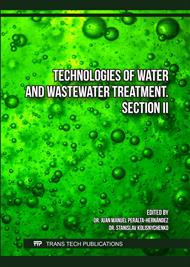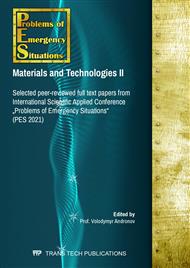[1]
M. Henze, Wastwater Treatment. Biological and Chemical Processes. Springer – Verlag Berlin Heidelberg, NewYork. (2002).
Google Scholar
[2]
M. Hubbe, J.R. Metts, D. Hermosilla, M.A. Blanco, L. Yerushalmi, F. Haghighat, P. Lindholm-Lehto, Z. Khodaparast, M. Kamali and A. Elliott, Wastewater treatment and reclamation: A review of pulp and paper industry practices and opportunities. BioRes. 11(3) (2016) 7953-8091.
DOI: 10.15376/biores.11.3.hubbe
Google Scholar
[3]
A.C. van Haandel, J.G.M. van der Lubbe, Handbook of Biological Wastewater Treatment: Design and Optimisation of Activated Sludge Systems. IWA Publishing, London. (2012).
DOI: 10.2166/9781780400808
Google Scholar
[4]
M. Henze, Biological Wastewater Treatment: Principles Modelling and Design. IWA Publishing, UK. (2008).
Google Scholar
[5]
S. Guangxi, Y. Zhang, G. Yingxin, H. Xiaogang, Y. Min, Removal of hard COD from biological effluent of coking wastewater using synchronized oxidation-adsorption technology: Performance, mechanism, and full-scale application, Water Research. 173 (2020).
DOI: 10.1016/j.watres.2020.115517
Google Scholar
[6]
∗ V. Iurchenko, O. Smyrnov, M. Yesin, Y. Levashova, Effect of the redox-potential on sludge liquor phosphatation in biological phoaphorus removal technologies, Water and Ecology. 24 (2019) 26-37 (into Russian).
DOI: 10.23968/2305-3488.2019.24.3.26-37
Google Scholar
[7]
R. Pishgar, J.A. Dominic, J.H. Tay, A. Chu. Pilot-scale investigation on nutrient removal characteristics of mineral-rich aerobic granular sludge: Identification of uncommon mechanisms, Water Research. 168 (2020).
DOI: 10.1016/j.watres.2019.115151
Google Scholar
[8]
C.H. Mobius, Abwasser der Papier-und Zellstoffindustrie, Wastwater of pulp and paper industry. 2010. Quelle: http://www.cm-consult.de, Datei AbwasserCM_415.pdf 352 p.
Google Scholar
[9]
O. Ashrafi, L. Yerushalmi, F. Haghighat, Wastewater treatment in the pulp-and-paper industry: A review of treatment processes and the associated greenhouse gas emission, Journal of Environmental Management. 158 (2015) 146-157.
DOI: 10.1016/j.jenvman.2015.05.010
Google Scholar
[10]
R. Mahshewari, B. Rani, A. Saxeno, M. Prasad, U. Singht, Analisis of effluents released from recycled paper industry, Journal of Advanced Scientific Reserch. 3 (1) (2012) 82-85.
Google Scholar
[11]
Q. Jiaxin, W. Kaichong, Q. Zhan et.al., Coupling ammonia nitrogen adsorption and regeneration unit with a high-load anoxic/aerobic process to achieve rapid and efficient pollutants removal for wastewater treatment, Water Research. 170 (2020) 115280.
DOI: 10.1016/j.watres.2019.115280
Google Scholar
[12]
Zh. Sapronova, S. Sverguzova, K. Sulim, A. Svyatchenko, E. Chebotaeva, Sewage treatment in megacities by modified chestnut tree waste, IOP Conference Series: Materials Science and Engineering. 365 (2) (2018). 022058.
DOI: 10.1088/1757-899x/365/2/022058
Google Scholar
[13]
V. Chemerys, E. Baltrėnaitė Pine-derived biochar as option for adsorption of Сu, Zn, Cr, Pb, Ni and decreasing of BOD5 in landfill leachate, Mokslas – Lietuvos Ateitis Science – Future of Lithuania. 9 (4) (2017) 406–412.
DOI: 10.3846/mla.2017.1068
Google Scholar
[14]
M.B. Ahmed, J.L. Zhou, H.H. Ngo, W. Guo, M. Chen, Progress in the preparation and application of modified biochar for improved contaminant removal from water and wastewater, Bioresource technology 214 (2016) 836–851.
DOI: 10.1016/j.biortech.2016.05.057
Google Scholar
[15]
V. Chemerys, E. Baltrėnaitė, A review of lignocellulosic biochar modification towards enhanced biochar selectivity and adsorption capacity of potentially toxic elements, Ukrainian Journal of Ecology. 8(1) (2018) 21–32.
DOI: 10.15421/2018_183
Google Scholar
[16]
Charcoal (organic fertilizer) Biochar, art. 20126.
Google Scholar
[17]
Ch. Soloviy, M. Malovanyy, I. Bordun, F. Ivashchyshyn, A. Borysiuk, Y. Kulyk, Structural, magnetic and adsorption characteristics of magnetically susceptible carbon sorbents based on natural raw materials, Journal of Water and Land Development. 47 (X–XII) (2020) 160–168.
Google Scholar
[18]
N.B. Azmi, M.J. Bashir, S. Sethupathi, C.A. Ng, Anaerobic stabilized landfill leachate treatment using chemically activated sugarcane bagasse activated carbon: kinetic and equilibrium study, Desalination and Water Treatment 57(9) (2016) 3916–3927.
DOI: 10.1080/19443994.2014.988660
Google Scholar
[19]
V.A. Bunetskyi, O.M. Hanzhenko, M.V. Roik, Biochar: high-caloric fuel and a source of high yield, Bioenergetics. 2 (12) (2018) 8-12. (in Ukraine).
Google Scholar
[20]
List of methods for performing measurements (determinations) of the composition and properties of samples of environmental objects, emissions, wastes and discharges provisionally allowed for use by the State Inspectorate of Ukraine, approved by the Head of the State Environmental Inspectorate of Ukraine – Chief State Inspector of Ukraine for Environmental Protection on 01.03.2013. (in Ukraine).
DOI: 10.24195/2414-9616.2019.3.3
Google Scholar
[21]
A.R. Mahdavi, A.A. Ghoresyhi, A. Rahimpour, H. Younesi, K. Pirzadeh, COD removal from landfill leachate using a high-performance and low-cost activated carbon synthesized from walnut shell, Chemical Engineering Communications. 205 (2018) 1193-1206.
DOI: 10.1080/00986445.2018.1441831
Google Scholar
[22]
M.A. Salahaldin, O.W.T. Abuabdoua, , M.J.K. Bashira, C.A. Ng, S. Sumathi, M.P. Lawrence, Treatment of tropical stabilised landfill leachate using palm oil fuel ash: isothermal and kinetic studies, Desalination and Water Treatment. (2019) 201–210.
DOI: 10.5004/dwt.2019.23662
Google Scholar
[23]
E. Ghizlane, B. Abdelaziz, Y. Abdelrani, L. Manfred, Biochar for Wastewater Treatment—Conversion Technologies and Applications, Appl. Sci. 10 (2020) 3492.
Google Scholar
[24]
Y.M.N.S. Ismail, N. Ngadi, M.H. Hassim, M.J. Kamaruddin, A.Johari and M.A.A. Aziz1, Preparation of activated carbon from oil palm empty fruit bunch by physical activation for treatment of landfill leachate, IOP Conf. Series: Materials Science and Engineering. (2018). 458: 012036.
DOI: 10.1088/1757-899x/458/1/012036
Google Scholar
[25]
V. Ptashnyk, I. Bordun, M. Malovanyy, P. Chabecki, T. Pieshkov, The change of structural parameters of nanoporous activated carbons under the influence of ultrasonic radiation, Applied Nanoscience (Switzerland). 10(12) (2020) 4891–4899.
DOI: 10.1007/s13204-020-01393-z
Google Scholar
[26]
H. Sakalova, M. Malovanyy, T. Vasylinycz, O. Palamarchuk, J. Semchuk, Treatment of effluents from ions of heavy metals as display of environmentally responsible activity of modern businessman, Journal of Ecological Engineering. 20(4) 2019 167-176.
DOI: 10.12911/22998993/102841
Google Scholar



